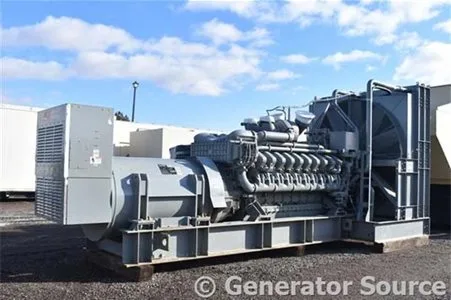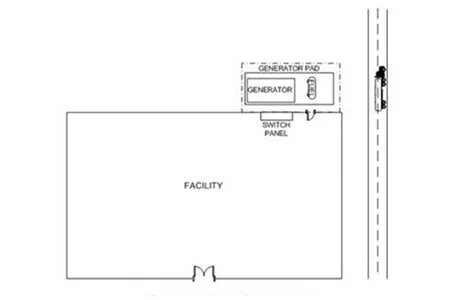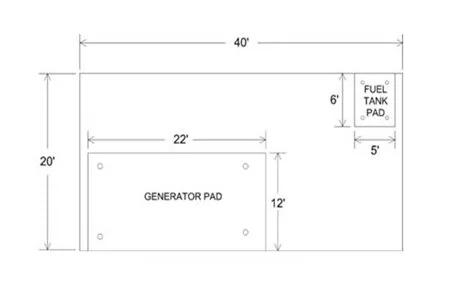Construction Site Planning
Purpose
This article explores different options available for various types of emergency generator applications. The applications discussed include generators exposed to weather and generators located inside of a facility.
- Permanent enclosed generator – Complete generator system housed in an enclosure that is located on a gravel or concrete pad.
- Portable enclosed generator – Generator system housed in an enclosure that is mounted on a trailer frame. Commonly used in construction sites. Easiest to complete initial setup on because the unit is self-sufficient.
- Generators located inside of a facility – Often can have redundant backup. Facility generators can be fueled by natural gas or diesel fuel. Day tanks are common in diesel fuel applications.

Permanent Enclosed Generator
Site Planning
When setting up the site, always use the generator manufacturer, state, and federal guidelines. It is helpful to design a basic drawing of the generator and supporting systems. Some considerations to be made are:
Basic Facility Layout
- Generator located with enough clearance between the building and fuel supply to allow major maintenance.
- Fuel supply located accessible to fuel truck.
- Security fence installation for safety purposes.
- Buried or above-ground fuel and electrical services.
The generator area can be designed to be large enough to fit the fuel tank and allow for major maintenance to be completed with ease.
Example:
A Caterpillar 1000 kW generator set was used in the creation of the generator area. The following statistics were used in calculations:
- Physical size of generator (21 ½’ x 11 ½’).
- Weight of generator with fuel tanks full (44,000 lbs.).
- Fuel consumption of generator (71 gal per hour full load).
- Back-up fuel supply tank (600 gallons).
Always consult local, state, and federal regulations when designing the generator area. Spill containment should be considered. Fuel stored between back-up fuel tank and generator fuel tank is 1200 gallons, allowing for 16 hours of continuous operation at full load.
Generator Area (Fictional)
Concrete Pad Design
It is not advised and against many building codes to place a generator set on gravel. The generator must be kept level and vibrates during operation and must be secured to a permanent structure. Concrete is the industry standard for normal soil applications.
Considerations:
- Ambient temperature for concrete pour (quick setting or normal).
- Weight concrete can withstand (heavy loads require reinforcement).
- Amount of pad protrusion past generator set (overall size plus ½”).
Concrete Anchors
Securing the generator set and backup fuel supply tank is usually completed using concrete anchors. Options include:
- Heavy Duty Anchor – Installed prior to concrete pour. Accurate measurements are imperative.
- Adhesive Bond – Concrete cured, hole drilled, epoxy, and stud installed. Stud must be square and level.
- Mechanical Bond – Concrete cured, hole drilled, stud set, and tightened.
Portable Enclosed Generator
Baldor 800 kW Portable Generator
Portable generators require less site preparation than any other style of generator. They are offered in a variety of sizes from the Caterpillar 320 kW to the Baldor 2000 kW.
Site Preparation
- Road established to location(s) of generator.
- If generator moves locations on-site, the area must be prepped prior to the move.
- Dimensions: 46’ x 9’, height 13’. Clearance to access and support the generator is required.
- Weight: 67,000 lbs. Use dunnage under rear wheels for support if soil is moist.
- Fuel usage under full load: 142 gallons/hour, with a 2800-gallon tank for 19.72 hours of operation.

Generators Located Inside Facility
Generators Inside Facilities
Generators located inside a facility are most commonly a self-contained system. The engine, generator, and engine cooling system are placed on a skid and factory aligned for operation.
Considerations
- Clearance for generator movement and placement onto a concrete pad.
- Facility lifting device: Construction fork truck, installed overhead crane system, or portable gantry system.
- Unloading from truck: Use a construction fork truck or crane to place in the prep area before locating in the facility.

MTU 3000 kW Indoor Generator
Site Preparation
Preparing a facility for a generator set installation includes setting up mounting and auxiliary systems. Consult federal, state, and local authorities before starting site preparation.
- Concrete pad: Must allow for generator maintenance and comply with regulations.
- Generator skid mounts: Attach mounts to pads, ensuring alignment and squareness.
- Intake air: Engine intake air must have a positive supply during operation.
- Fuel supply: Fuel piping may need to be under floor level and protected by grating.
- Electrical drops: Have electrical drops ready for use after installation.
- Cooling air: Ductwork with louvers can be installed for generator attachment.
- Exhaust: Install an exhaust system for the building before the generator set installation.